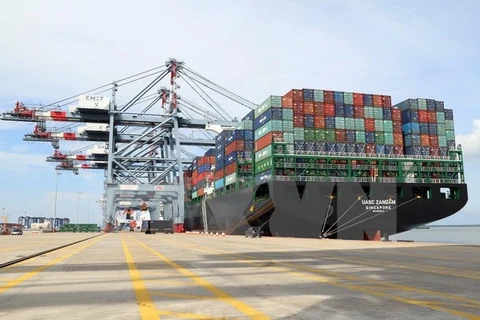 WB Country Director for Vietnam Ousmane Dione speaks at the release of the report in Hanoi on December 11 (Photo: VNA)
WB Country Director for Vietnam Ousmane Dione speaks at the release of the report in Hanoi on December 11 (Photo: VNA) Hanoi (VNA) – The World Bank (WB) expects Vietnam’s economic growth this year at nearly 6.8 percent, compared to the 6.3 percent projected for East Asia and the Pacific, in a report released on December 11.
In the report “Taking Stock: An Update on Vietnam’s Recent Economic Economic Developments”, the WB said the country’s outlook remains robust despite growing external headwinds, which is supported by strong domestic demand and a dynamic export-oriented manufacturing sector.
The growth in the medium term is forecast to decelerate incrementally to 6.6 percent and 6.5 percent in 2019 and 2020, respectively. Inflation is expected to remain muted, at about the State Bank of Vietnam’s target of 4 percent, given anticipated monetary policy tightening over the medium term.
Meanwhile, risks to the outlook have intensified and are tilted to the downside. Domestically, a slowdown in the restructuring of the state-owned enterprise and banking sectors could undermine growth prospects and create public sector liabilities. Vietnam also remains susceptible to external volatility, given its high trade openness and limited fiscal and monetary policy buffers.
Escalating global trade tensions could affect Vietnam’s export-oriented prospects, and a falloff in external demand could lead to weaker external positions and lower GDP growth. Tightening global liquidity could reduce capital inflows and put downward pressure on the Vietnamese dong and asset prices, according to the report.
The report’s special focus is on the streamlining and improvement of the transparency of non-tariff measures (NTMs) to facilitate trade. While tariffs have been decreasing along with the process of international economic integration, the number of NTMs has increased rapidly.
Vietnam’s average preferential tariffs have fallen from 13.11 percent in 2003 to 6.33 percent in 2015. In contrast, the number of NTMs has increased by over 20 times in the period.
NTMs, if poorly designed and implemented, can restrict trade, distort prices, and erode national competitiveness, the report says, adding that the NTM system in Vietnam remains complicated, opaque, and costly. –VNA
VNA
























